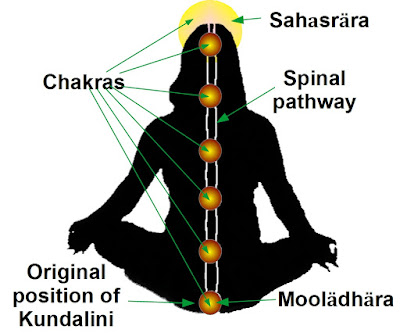For many people, Kundalini is an inalienable part of Yoga.
They talk about the dormant mystic power Kundalini, an array of energy centers called Chakras spread all over the spine starting from the lower tip of the vertebral column to the top of the skull.

But few people are aware that the concept of Kundalini is not part of Yoga proper. It is an artefact of Hatayoga with only a few centuries of recorded history.
I have gone into greater details about this mystic concept of Hatayoga in my book “Hatayoga myths shattered” where I have almost called it as a myth.
Myth or no myth, there are quite a few meditation techniques based on this mystic notion of Kundalini.
Earliest among these techniques is probably the so called Nadopasana that appears in Hatapradeepika. Hatapradeepika is a 15th century text on Hatayoga by Swami Svatmarama. The Yoga in vogue today owes to this 15th century text.
The central theme of Hatayoga is that there is a dormant force called Kundalini in the perineum area, that needs to be aroused by means of Hatayoga practice. Once aroused, this mighty force raises its hood and hisses like an angry female serpent.
This Kundalini is then guided gradually up the spinal pathway to finally unite with its male counterpart in the top of the head. This power passes through various energy centers called Chakras situated at various places along the way.
 |
| Nada or sound moving up the spine |
To start with, this sound is supposed to be harsh and gradually gets refined as the Kundalini moves up on its way.
The Nadopasana of Hatayoga involves focusing the Mind on these sounds. Or in other words, you just follow the rising of the Kundalini as indicated by the sound. And when the Kundalini reaches its destination, the meditation culminates.
Many Hatayogis swear that such sounds are indeed produced and can be perceived. But my study of Hatayoga texts reveals that the entire process is more of a mental imagery than based on any real happening.
All the same, Nadopasana can be a good way of stilling one’s mind, even if the sounds are only imaginary. The highly imaginative way in which the entire Kundalini idea is put forth and its support by great many modern Yogis, provides necessary mental conditioning, making it a very good meditative target.
There is also a group of modern Yoga teachers, who do not wish to identify themselves with Hatayoga. But they adapt the Nadopasana of the Hatayoga as a vehicle for their brand of meditative practice.
They imagine some energy that keeps moving up and down the spine, moving through various chakras and they suggest meditating on the movement of that imagined energy. They give it a new name; Trace its origin to ancient texts such as Bhagavad Gita or even Upanishads; Re-interpret various verses in these scriptures to read their techniques into them, and so on.
One of the Gurus even goes a step further and asks you to imagine ‘tap lights’ fitted at various locations on the spinal pathway. You imagine moving up the spinal pathway and keep tapping on respective lights as you reach them. The light will be ON when you tap them. And finally, after having reached the topmost light make a reverse march, tapping each light OFF! Very imaginative indeed.
I wonder whether such imageries are essential for meditation! Probably, since most modern Gurus whip up a craze for mystery through their autobiographies and others books, it becomes essential for them to keep up this longing for mystery. So, they come up with highly imaginative ways of meditation.
As long as the ultimate goal is to attain a tranquil mind which opens itself to greater visions of existence, even these meditation techniques may be acceptable. But as one great Yogi Ramana Maharshi once pointed out – “does one need such a circuitous route and imaginary concepts?”.
May be modern people with over indulgence in sense pleasures and a longing for mystery, cannot just collect their scattered minds through simpler means!
On the negative side, I suspect that mysticism may hinder clarity of thought, and make the mind further restless. If that happens, one would get lost in the gullies of imagination. And what results is nothing short of hallucination!
Let us continue our discussion in the next episode.
A series revolving around Mind – Science of Mind, Philosophy of Mind, Notions of reality, Mind modulation, Domains beyond Mind, and so on. © Dr. King, Swami Satyapriya 2019-2020

No comments:
Post a Comment